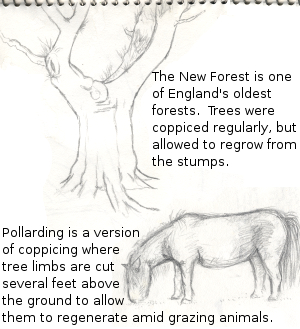
Roots of permaculture
 I've
bandied about words like permaculture and forest gardening with great
abandon in the last year. But what do they mean? Where did
they come from? This week's lunchtime series attempts to fill
that gap so that I can go back to the delightful nitty gritty.
I've
bandied about words like permaculture and forest gardening with great
abandon in the last year. But what do they mean? Where did
they come from? This week's lunchtime series attempts to fill
that gap so that I can go back to the delightful nitty gritty.
Both permaculture and forest gardening are ways of feeding ourselves
without demolishing the environment. Think of them as organic
gardening, cubed. The concepts (which I'll go into later) are
reactions to modern agroindustrial systems that spray, fertilize, and
till the natural ecosystem into submission, using more energy to
produce crops than we get out in useful food. Obviously, the
modern monoculture system isn't sustainable. But how can we feed
the world without it?
Permaculture goes back to basics, reminding us that we did manage to
feed ourselves before chemical fertilizers and monoculture came
along. Remember how Amazonians
produced edible forests that look so natural scientists are only just
beginning to realize they are man-made? How Central
Americans left serviceberries in their vegetable fields as a source of
mulch, or raked
organic matter out of nearby woodlands?
Did you know that Europeans have used coppicing to turn forests into
sources of fuel, fiber, fodder, and mulch for hundreds of years?
All of these systems are examples of ways that people have worked with
the natural world rather than against it and still managed to make a
living. Can't we do the same?
| This post is part of our History of Permaculture lunchtime series.
Read all of the entries: |
Want more in-depth information? Browse through our books.
Or explore more posts by date or by subject.
About us: Anna Hess and Mark Hamilton spent over a decade living self-sufficiently in the mountains of Virginia before moving north to start over from scratch in the foothills of Ohio. They've experimented with permaculture, no-till gardening, trailersteading, home-based microbusinesses and much more, writing about their adventures in both blogs and books.
Want to be notified when new comments are posted on this page? Click on the RSS button after you add a comment to subscribe to the comment feed, or simply check the box beside "email replies to me" while writing your comment.
